Planting and caring for zinnia outdoors
The slender and proud flower hats of the zinnias look like the staunch tin soldiers. They begin to appear at the beginning of summer and continue to delight with their uncomplicated beauty until the very frost. The unpretentious plant has many varieties, among which it is easy to find "your" flower.
Appearance
Zinnia is a genus of one - or perennial herbaceous plants or shrubs from the Astrov family. The people called her "Major". The height of the flower is from 30 to 100 cm, depending on the variety. The diameter of the inflorescences is from 3 to 14 cm, they are singly located on long peduncles. Flowers in a wide variety of shades, except blue: white, purple, orange, red and yellow. A pleasant feature of zinnia is the long flowering period, from mid-June to frost. There are more than 22 species of this plant.
- Zinnia graceful - an annual with simple, double or semi-double flowers with a diameter of 5 to 16 cm. Its straight stem can reach a height of more than a meter. Leaves are ovoid with a pointed tip. Graceful zinnia has many different varieties and hybrids, which differ in size, shape of inflorescences and flowering times. The taller varieties are grown primarily for cutting. Low-growing ones are used to decorate flower beds, and are also planted in flowerpots and balcony containers. If watering is not enough in hot and dry weather, the inflorescences become smaller and lose their rich color.
- Zinnia angustifolia - upright annual with branched stems. Its numerous varieties are distinguished by shades of small inflorescences. They are orange, red, lemon, brownish, white, and yellow. The flowers are simple and double, many varieties have a border of a different color.
- Thin and sharp leaves zinnia linearis resemble narrow-leaved zinnia. It is the smallest decorative species of the popular plant, reaching a maximum height of 35 cm. Small flowers with yellow buds and orange border are often grown in pots.
Hybrids of graceful and narrow-leaved zinnias amaze with a variety of colors and shapes of petals. They are more resistant to unfavorable growing conditions. There are flowers with very lush inflorescences, plants with stripes and spots on the petals, varieties with a purple color have appeared.
According to the shape of the inflorescences, zinnias are divided into dahlia, pompom and chrysanthemum. Dahlia and chrysanthemum-like varieties in appearance of inflorescences are similar to plants of the same name, and pompom (lilliputian) zinnias are compact bushes with a large number of shoots and a mass of small flowers.
Reproduction
For zinnias, the seed propagation method is used. Young specimens of the plant can be obtained by seedling or non-seedling methods. Zinnia seeds die in the ground already at a temperature of -1 degrees. In regions with a warm climate, sowing is carried out directly into open soil, in cold regions it is more efficient to pre-grow seedlings.
- Works begin to be carried out not earlier than the end of March or the beginning of April. Seedlings grow quickly, and if sown too early, already almost adult plants are easily damaged during transplantation and take root less well in a new place.
- A few days before sowing, the seeds are placed on a damp cloth; you can pre-soak them in Epin's solution. Depending on age, they hatch after 2 days (fresh), in old ones, the process takes up to 7 days.
- Sowing is carried out in a moist nutrient substrate in 2-3 pieces, deepening into the ground by about 1 cm. Two-thirds of the pot is filled with soil. You need sufficiently wide containers with a depth of at least 10 cm.Vases are chosen not too small so that there is no need to dive the plants in the future - zinnia does not like this procedure.
- The containers are covered with foil or glass, transferred to a bright room with a temperature of about +23 degrees. The soil should always be slightly damp, but swamps should not be allowed.
- When the first shoots appear in a few days, the film is removed. It is important that the seedlings are in bright, diffused light. In partial shade, young plants will stretch out. If this happens, soil is poured into the pot.
- From the end of May, the seedlings begin to harden. It is taken out into the street in the daytime, gradually increasing the time spent in the fresh air.
- Transplanting to a flower bed is carried out towards the end of May, when there is no longer a danger of recurrent frosts. The first flowers on plants can be seen about 2.5 months after sowing the seeds.
When sowing zinnia directly into open ground, it is convenient to place adjacent specimens at a distance of 10 cm from each other, the seeds are sealed to a depth of no more than a centimeter. When the seedlings get 3-4 leaves, the flowers are thinned out. "Extra" specimens are carefully dug up and planted in another place. This option of growing zinnia takes less time. You can enjoy the flowers on average 1.5-2 months later than with the seedling method.
How to plant zinnias?
In the fall, they begin to prepare a site for a future flower garden. It is cleaned of plant residues, debris and other elements. Humus or rotted manure is introduced (use about 9 kg of fertilizer per square meter of area). Then the site is dug to a depth of at least 45 cm.
In the spring, the place for flowers is re-loosened. When planting, zinnias are placed at a distance of about 35 cm from each other. For tall varieties, the interval between plants is increased to 40 cm. Dwarf varieties are planted, observing a gap of 20 cm. During transplantation, you can pinch the root, shortening it by about two centimeters. Such plants take root more easily and grow a powerful root system faster in the future. During planting, seedlings can be deepened into the ground to the level of the cotyledonous leaves. Over time, they will become overgrown with adventitious roots.
At first, care for young plantings is enhanced, they are often watered, especially in hot weather. After moistening, the aisle is loosened.
Growing features
Getting beautiful zinnias in a flower garden is not at all difficult if you create the right conditions for them.
- You need to plant the plant in a sunny area without drafts. This heat and drought tolerant flower tolerates sun exposure more easily than shade. Abundant flowering can be achieved only in areas protected from strong winds.
- The plant loves a nutritious and well-drained soil with neutral acidity. Stagnation of water in areas where zinnium is grown is unacceptable. Sod land is added to the loamy soil.
- The flower is very sensitive to temperature drop. Even with the slightest spring or autumn frosts, the plant suffers.
- Loosening the soil is carried out regularly, at the same time getting rid of weeds on the site.
- When watering, they try not to wet the flowers, as this can provoke their decay. Water is poured at the root. Moisture should be abundant, but infrequent. On average, watered once a week. In hot weather, the procedure is carried out more often, with a decrease in temperature, the amount of irrigation is reduced.
- The life of one zinnia inflorescence lasts about a month. If it is not planned to be used to collect seeds, then the wilted flowers are removed. This will preserve the strength of the plant, which will be useful for further continuous flowering.
- You can get a more lush bush of zinnia by pinching. The operation is performed on young plants over the 3-5th pair of leaves. You can pinch them while growing seedlings or after transferring flowers to open ground. If the work is carried out on a flower bed, but you need to wait until the zinnia lives and takes root.Pinching is not carried out for flowers that are grown for cutting, because in this case there will be no very long peduncles with large single flowers.
- Organic food is introduced in the fall, using rotted manure or humus. The first time the seedlings are fertilized while growing in pots. The procedure is repeated twice more on young plants. 30 days after planting zinnias in open ground, fertilizing with mineral fertilizer is performed again. The event is repeated when the buds appear. Introduce nitrophosphate, potassium sulfate or superphosphate (1 tablespoon per square meter of area with flowers).
Zinnia seeds ripen approximately 60 days after flowering. It is better to collect the seed from the inflorescences that opened first. Flowers with the most attractive color and no signs of disease can be noted. Lateral shoots are removed from these specimens. The seed baskets are cut when they are brown. Then they are dried, seeds are selected and cleaned of flower residues. Seed material is placed in paper bags and signed. Then placed in a dry place. It retains good germination for 3-4 years.
Zinnia is a perennial. If it was grown in a hanging pot or container, then you can save the plant during the winter. To do this, it is taken into the house when it gets cold and looked after like a house flower. You can do the same with undersized varieties that are grown in the open field. In the fall, they are transplanted into suitable containers and transported indoors.
Diseases and pests
Various parasites can inhabit zinnia. When aphids attack, control measures depend on the number of pests. Small colonies can be destroyed by sprinkling with a solution of tar soap (10 g per 10 L of water). In case of severe aphid infestation, they are treated with an insecticide, for example, "Aktellik".
May beetles, slugs and snails love to feast on the plant. They are collected by hand and destroyed. For clams, you can additionally make "tasty" traps. Small containers with beer are placed on the area with flowers and covered with pieces of slate, boards or roofing felt. From time to time, these places are checked and the pests found are collected.
Zinnia can suffer from various diseases. Most often, they develop on plants with too thick planting, prolonged rains, or excessive watering.
- Bacterial spotting causes round gray-brown spots on the leaves. The damaged areas are removed, with a strong infection, the entire plant is removed. The flower cannot be cured.
- A sign of gray mold is downy mildew on the leaves and stem. Colloidal sulfur or "Fundazol" will help get rid of the disease.
- Powdery mildew can be caused by an excess of organic matter in the soil and a lack of moisture. A flour-like grayish coating appears on the leaves and petals of the plant. In this case, you need to carry out treatment with "Topaz", "Vectra" or "Fast".
- Light mold on the leaves and peduncle necrosis is observed with oidium. Flowers located next to the vineyard often suffer from this disease. The vine is a common source of this disease. It is necessary to spray with colloidal sulfur zinnium.
- Fusarium is seed-borne and can also be found in contaminated soil. First, the root system suffers, then the fungus spreads throughout the plant. Leaves droop, stems rot. It is necessary to treat plants and land on the flower garden with a fungicide.
Use in landscape design
Along with chamomiles, calendula, bells, marigolds and marigold zinnia is a popular plant for rustic flower gardens. Tall varieties are used for planting in mixborders, miniature species are used for borders.
The plant is actively used in cutting. For these purposes, half-open zinnias are chosen, which have opened their buds by three quarters. In bouquets, flowers last a week, some types - up to two weeks.If the cut is processed correctly, the plant will decorate the house longer. It is shortened slightly in hot water or the ends of the stems are burned and then placed in a vase.
Zinnia is a flower whose popularity is justified. With minimal maintenance, you can create a flower garden out of these beautiful plants that will attract attention from early summer to late autumn.
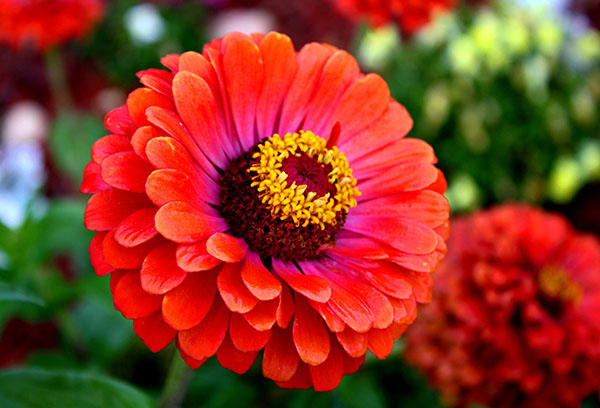

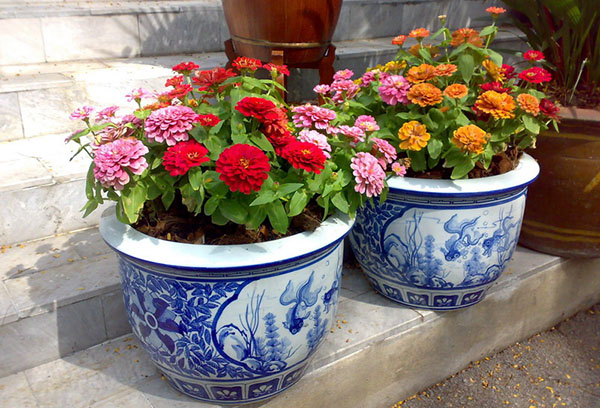


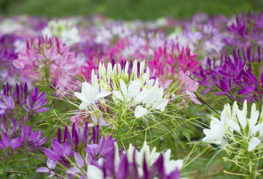
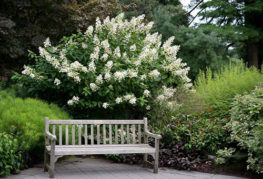

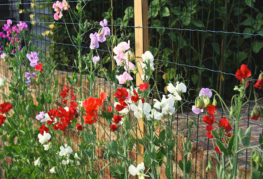
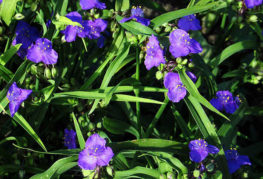
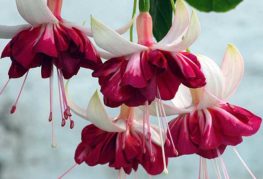
and will be published shortly.